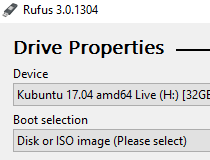
- RUFUS ISO WONT READ HOW TO
- RUFUS ISO WONT READ FULL VERSION
- RUFUS ISO WONT READ INSTALL
- RUFUS ISO WONT READ WINDOWS 10
- RUFUS ISO WONT READ WINDOWS 7
In the "Choose the download you want" table, mark the installer with your preferred language and click the "Next" button.
RUFUS ISO WONT READ WINDOWS 7
If you run Windows 7 and need to create a bootable USB flash drive for Windows 10, you have an option to use the Windows 7 USB/DVD Download Tool.įirst, download the Windows 7 USB/DVD Download Tool. Click the Close button to exit the Rufus application. At the end of its operation, the status line will display "READY".
RUFUS ISO WONT READ WINDOWS 10
It takes Rufus about 20 minutes to a create bootable Windows 10 USB flash drive from an ISO file. In the Open dialog, point to the Windows 10 ISO file. You may change the label of the USB bootable drive if you wish under New volume label. Click the disk icon in the Rufus window. Leave the Cluster size at its default setting. The difference between UEFI and BIOS modes is explained in the article Boot to UEFI Mode or legacy BIOS mode. If you're going to use the bootable USB drive on the computer with UEFI or legacy BIOS under Partition scheme and target system type, select a GPT partition scheme for UEFI or MBR partition scheme for BIOS or UEFI, correspondingly. Under Device options, select the USB flash drive you want to convert to Windows 10 bootable. Run the Rufus application and select the settings as shown in the screenshot below: In the example below, we use a 16 GB USB flash drive. This is an executable file that can be launched without installation.Ĭonnect a USB flash drive with 8GB or more capacity that you wish to use as your USB flash bootable drive. You can use Media Creation Tool to download a Windows 10 ISO file or download it from here.ĭownload the latest version of the Rufus executable file. Follow these steps:įirst, obtain a Windows 10 ISO file. The Rufus application can create a bootable USB flash drive from a Windows 10 ISO file. The amount of disk space used on the bootable USB flash drive is around 5 GB. When the bootable USB is created, it will contain the folders and files shown in the screenshot below. After download, the Creating Windows 10 media process will be executed in the background for an additional 30 minutes. It may take up to 30 minutes to download Windows 10, depending on your Internet connection's throughput. Otherwise, follow the steps below to download and run Windows 10 Media Creation Tool.ĭownload Windows 10 Media Creation Tool from the Microsoft server by pressing the Download tool now button in the Create Windows 10 installation media paragraph. If you are concerned about this duration, you may wish to consider other options in this article. Usually, it takes around one hour to download and create a bootable USB flash drive with installation media using Media Creation Tool. On the other hand, it is not the fastest method, especially if you already have a Windows 10 or Windows 11 ISO file downloaded on your computer. The Windows 10 Media Creation Tool option perhaps requires the least interaction with the user. Combo Cleaner is owned and operated by Rcs Lt, the parent company of read more.
RUFUS ISO WONT READ FULL VERSION
You will need to purchase the full version to remove infections and eliminate computer errors. It is recommended to run a free scan with Combo Cleaner - a tool to detect malware and fix computer errors.
RUFUS ISO WONT READ HOW TO
How to Create a Bootable Windows 10 USB Flash Drive: Video Showing How to Create a Bootable USB Flash Drive in Windows:
RUFUS ISO WONT READ INSTALL
If you want to install Windows 10, you can get its ISO here: Download Windows 10 ISO file. If you want to install Windows 11, you can get its ISO here: Download Windows 11 ISO file.


Most options in this article (except Option 1) assume that you already have a Windows Disk Image (ISO file). Using a bootable USB flash drive, you can install a new copy of Windows, perform a clean installation, or reinstall Windows 10 or Windows 11. Therefore, an 8 GB USB drive is recommended for this purpose. For Windows 11, you need more than 5 GB of free space. When you boot from a USB disk, the Windows installation is started after the computer is powered up. This tutorial shows several methods to create a bootable USB flash drive containing a Windows installation. To Install or reinstall Windows 10 on a computer, you can use a bootable USB disk (USB flash drive).

How to Create a Bootable Windows 10 USB Flash Drive


 0 kommentar(er)
0 kommentar(er)
